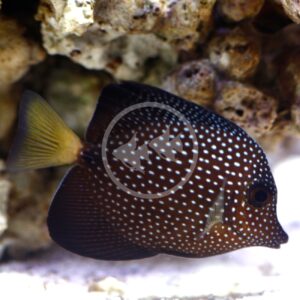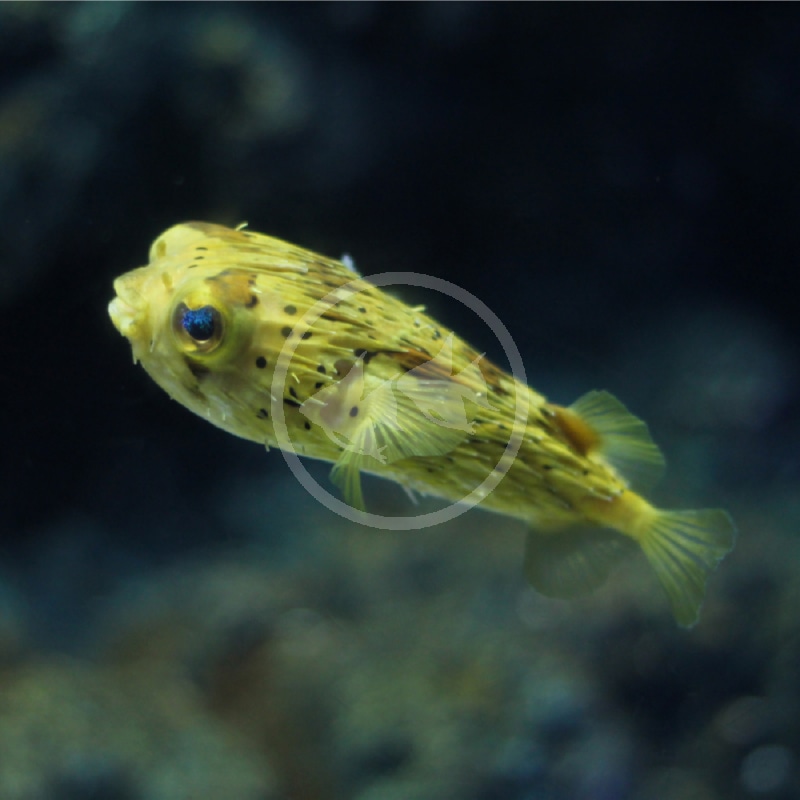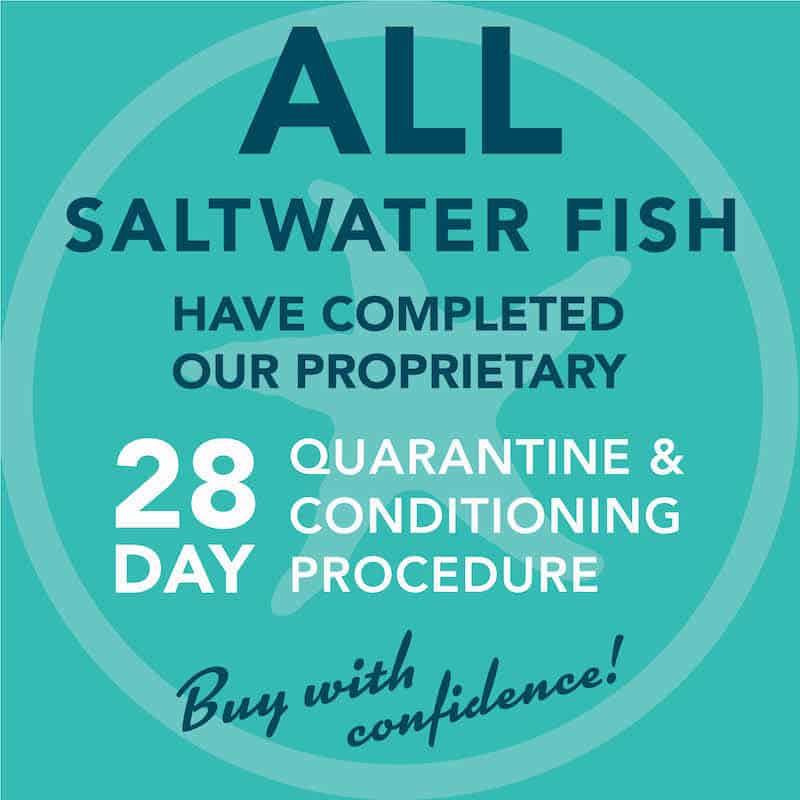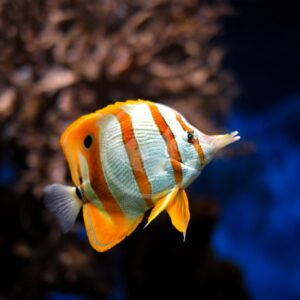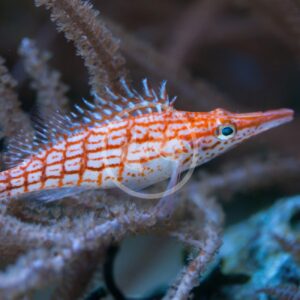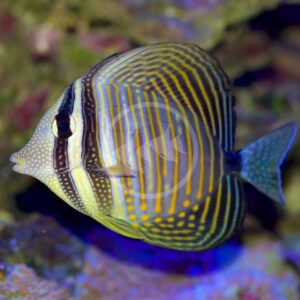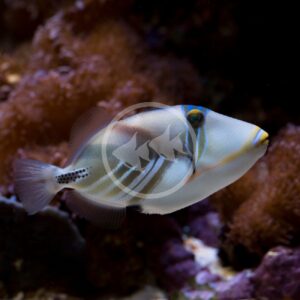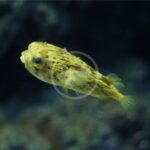

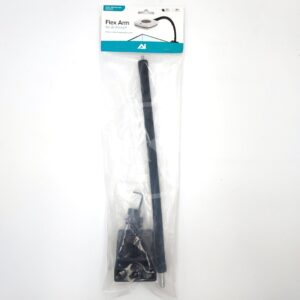
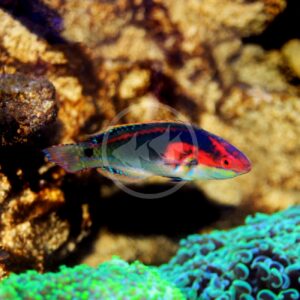
PUFFER – PORCUPINE Diodon holocanthus
$149.99 – $399.99
The Porcupine Puffer has a wide geographic distribution in the wild and may be one of the most iconic pufferfish in the saltwater hobby. Recognized by its puppy-dog like appearance and spines, the Porcupine puffer will inflate to over two times its original size if under stress, or felt threatened by a tank-mate, into a sphere shape with all of these spines erected. Do not purposely entice this behavior, as it can have adverse health effects and in some circumstances, cause death to your puffer. After drip acclimation in a bucket, it is imperative to transfer your puffer in a tupperware container with water to the main aquarium. There are two reasons you do not want to transfer your puffer in a net: 1. The spines could get stuck, and 2. If the puffer inflates out of the water, it’s sucking in air which is much more diffcult for it to expel. Porcupine puffers are known to recognize hobbyists as their caregivers and will even beg for food. Some individuals have even been observed to spit water out of the aquarium to gain attention! These quirky behaviors certainly make the Porcupine puffer a playful and engaging addition to any large fish only with live rock aquarium. An adult Porcupine puffer can reach an approximate size of 12″.
Care Level: Moderate
Temperament: Semi-Aggressive
Reef Compatible: No
General Description: The Porcupine Puffer has a wide geographic distribution in the wild and may be one of the most iconic pufferfish in the saltwater hobby. Recognized by its puppy-dog like appearance and spines, the Porcupine puffer will inflate to over two times its original size if under stress, or felt threatened by a tank-mate, into a sphere shape with all of these spines erected. Do not purposely entice this behavior, as it can have adverse health effects and in some circumstances, cause death to your puffer. After drip acclimation in a bucket, it is imperative to transfer your puffer in a tupperware container with water to the main aquarium. There are two reasons you do not want to transfer your puffer in a net: 1. The spines could get stuck, and 2. If the puffer inflates out of the water, it’s sucking in air which is much more difficult for it to expel. Porcupine puffers are known to recognize hobbyists as their caregivers and will even beg for food. Some individuals have even been observed to spit water out of the aquarium to gain attention! These quirky behaviors certainly make the Porcupine puffer a playful and engaging addition to any large fish only with live rock aquarium. An adult Porcupine puffer can reach an approximate size of 12″.
Diet Requirements: In the wild Porcupine puffers are carnivorous. A diet consisting of various meaty frozen foods is necessary and options will depend on the size of the individual. Some examples include brine shrimp, squid, mysis shrimp, and krill to maintain optimal health and color. Hard-shelled shrimp and clams with shells are also highly encouraged to feed from time to time in order to keep their teeth worn down. Overgrown teeth will cause complications and have consequences.
Care Requirements: A minimum 125 gallon aquarium is required for medium sized Porcupine puffers. Larger individuals will need an aquarium greater than 200 gallons. Additionally, aquariums that house large species of pufferfish should be equipped with a protein skimmer and above average filtration because of their bioload capacity. Porcupine puffers may appreciate some large rock arches to take refuge at night, but need more open swimming and turning space. Given their nature, Porcupine puffers can be kept in an active peaceful to semi-aggressive aquarium or more aggressive aquarium. It is best to take into consideration the size of the puffer at the time and choose tank-mates accordingly. Puffers should not be kept with small fish or slower fish with decorative fins that they could nip at. Porcupine puffers do not make good reef aquarium inhabitants because of how messy they can be, but they will also eat invertebrates including crabs, urchins, starfish and shrimp. Porcupine puffers have been kept together successfully, but we suggest attempting this at smaller sizes only. Recommended water conditions, 72-78° F, KH 8-12, pH 8.1-8.4, salinity 1.020-1.025.
Purchase Size: Small: 2″ to 3″; Medium: 3-1/4″ to 4-1/4″; Large: 4-1/2″ to 5-1/2″; XLG: 5-3/4″ to 8″; XXLG: 8″+
Note: Your item may not look identical to the image provided due to variation within species. Purchase sizes are approximate.
Dry goods orders are shipped via US Postal Service or UPS to the address provided at checkout based on the selection made in your website shopping cart. Product is carefully packed to help prevent any damage during shipping. Once processed you will receive a shipment notification via email with tracking number, and delivery notification. Please allow 48 hours for processing after your order is placed.
Perishable items (i.e. live plants, refrigerated/frozen foods) are shipped via US Postal Service 2-3 day to the address provided at checkout for a $25.00 flat rate charge. Items are packed with secure packing material and heat, cold, or Cryo packs as needed to maintain safe temperatures during transit. If one or more perishable items are in the shopping cart at checkout the $25.00 perishable shipping charge will automatically appear and need to be selected. Once processed you will receive a shipment notification via email with tracking number. Please allow 48 hours for processing after your order is placed.
Livestock (i.e. fish, invertebrates, coral) are shipped via UPS Overnight to the address provided at checkout for a $55.00 flat rate charge. Livestock is packed in insulated styrofoam boxes with secure packing material and heat, cold, or Cryo packs as needed to maintain safe temperatures during transit. If one or more livestock items are in the shopping cart at checkout the $55.00 livestock shipping charge will automatically appear and need to be selected. Livestock is shipped Monday through Wednesday ONLY (no weekend delivery is available) weather permitting, and we reserve the right to delay shipping until conditions are appropriate for safe arrival. Once your order is placed we will contact you to arrange the best shipping date based on these criteria. Someone must be available to receive the livestock order on the first delivery attempt. Once processed you will receive a shipment notification via email with tracking number. Please allow 48 hours for processing after your order is placed.
For mixed dry goods/perishable & livestock orders items will be shipped via their corresponding shipping methods outlined above. Dry goods will be shipped via US Postal Service or UPS based on your selection and checkout, while livestock will ship via UPS Overnight for a $55.00 flat rate charge. You will receive separate notifications and tracking numbers for the dry goods and livestock. Please note due to different carriers and shipping methods dry goods and livestock may arrive on different days.
Related products
BUTTERFLY – COPPERBAND Chelmon rostratus
$109.99 – $219.99HAWK – LONGNOSE Oxycirrhites typus
$129.99 – $159.99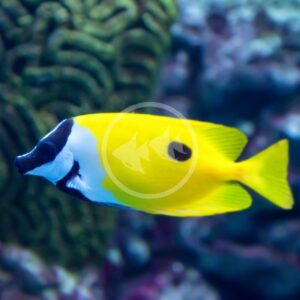

RABBITFISH – ONE SPOT FOXFACE Siganus unimaculatus
$119.99 – $169.99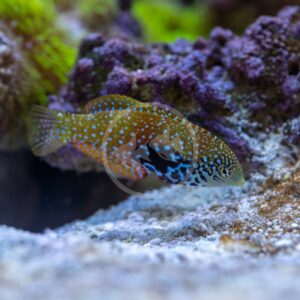

WRASSE – LEOPARD VERMICULATE Macropharyngodon bipartitus
$129.99TANG – SAILFIN DESJARDINII Zebrasoma desjardinii
$169.99 – $199.99TRIGGER – HUMU HUMU Rhinecanthus aculeatus
$89.99 – $139.99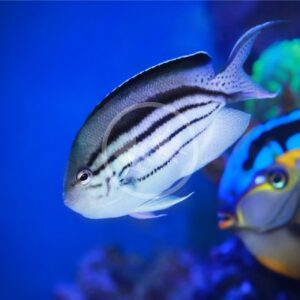

ANGEL – LAMARCK Genicanthus lamarck
$99.99 – $299.99